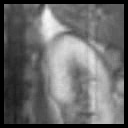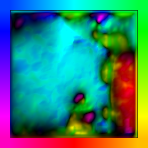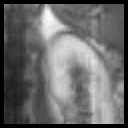 E2 - JX(s)
E2 - JX(s) ∈ [1 - ε,1 + ε] for almost all s ∈ Θ ⊂ Ω, ε sufficiently small.
∈ [1 - ε,1 + ε] for almost all s ∈ Θ ⊂ Ω, ε sufficiently small.
In the image registration problem, one searches for a deformation X(s): Ω → R2, which brings two greyscale images I0(s), I1(s): Ω → [0,1] in good correspondence via I1(s-X(s)) ≈ I0(s). Elastical registration tries to find X in accordance with an underlying elasticity model for the deformation of the imaged bodies.
This problem has been widely formulated as a multidimensional variational problem, which is solved by indirect methods. Our goal is to improve the variational model by incorporation of constraints and to solve the resulting optimal control problem by direct methods instead of indirect ones.
∙ Constraints for validity of the underlying elasticity model: convex control restriction JX(s) ∈ K ⊂ R2×2 for almost all s ∈ Ω reflecting the fact that the shear stress generated by X should remain bounded.
∙ A priori known subregions Θ with small deformation: state constraint ∥X(s)∥≤ ε for all s ∈ Θ ⊂ Ω, ε sufficiently small.
∙ A priori known subregions Θ with nearly rigid deformation: convex or polyconvex control restrictions ∥JX(s)∥≤ ε
resp. Det E2 - JX(s)
E2 - JX(s) ∈ [1 - ε,1 + ε] for almost all s ∈ Θ ⊂ Ω, ε sufficiently small.
∈ [1 - ε,1 + ε] for almost all s ∈ Θ ⊂ Ω, ε sufficiently small.
With regard to the envisaged applications in medical imaging, we will study objectives with regularization terms according to Hooke’s law as well as to different kinds of hyperelastic laws.
We arrive at multidimensional control problems, e. g. with hyperelastic regularization:
![∫ 2 ∫ p 2
F(X ) = Ω(I1(s- X (s))- I0(s)) ds+ μ ⋅ Ω(c1∥E2 - JX (s)∥ + c2(Det(E2 - JX (s))) )ds -→ inf!;
1,p 2 4 2×2
X ∈ W 0 (Ω,R );JX (s) ∈ [- R,R ] ⊂ R for a. a. s ∈ Ω](wagner2x.png) |
with 1 < p < ∞, μ > 0 and weights c1, c2 > 0. Further state constraints and control restrictions may be added. Justified by existence theorems involving generalized notions of convexity, the numerical solution of the problems will be obtained by immediate discretization and subsequent large-scale optimization.
 |  |  |
| (a) Template I1 |
(b) Colorful orientation plot of X |
(c) Reference image I0 |